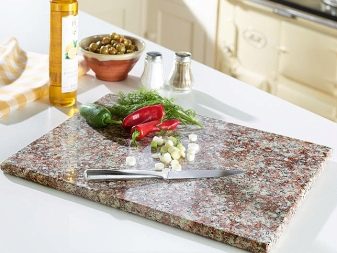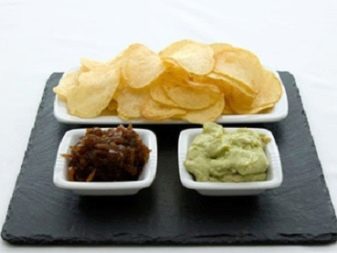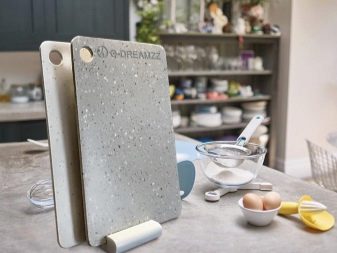Cutting board is a must-have in every kitchen. With its help, processing and slicing of products is carried out, all culinary masterpieces are embodied in reality. Therefore, when choosing a board should pay attention to the quality characteristics of the product. A very popular stone cutting board is represented by a wide variety of shapes and colors; it has a high level of wear resistance compared to plastic and wooden boards.

Kinds
Most often, stone cutting boards are a solid flat slab of marble or granite, as well as artificial stone.
Serving or cutting plates made of granite and marble are characterized by high environmental performance, have bactericidal properties, since only natural materials without caustic impurities and dyes are used for their manufacture.
The surface of natural stone does not absorb extraneous odors and does not allow the tastes of the products to mix, while maintaining their natural qualities.


High-strength artificial stone cutting board is made according to Italian technology from a natural mineral with the addition of coloring components and resins. Such products have a luxurious and sophisticated look, almost identical to natural stone boards. At the same time, the artificial version of the cutting surface has a more affordable price and has a long service life (more than 15 years), in addition, such accessories are suitable for all types of kitchen work.
Surfaces made of acrylic material do not have pores and microcracks in which bacteria and fungi can accumulate, for this reason, food products cut on such a board retain their useful properties.


Rules for selection and operation
It is believed that the kitchen of an average housewife requires at least 3 cutting boards to ensure the necessary level of hygiene and food safety. One should be for slicing bread and confectionery, the second for meat products, and the third for vegetables and fruits. Each culinary specialist has the right to independently determine the necessary number of cutting boards, while they can be of various sizes and from different materials.
When operating cutting boards, it must be taken into account that for each group of products there should be a separate surface. This is due to the fact that, for example, raw fish and meat can contain various harmful microorganisms, which, if they come into contact with a product that is not subjected to heat treatment, can cause significant harm to health.


The main requirements that you should pay attention to when choosing a stone cutting board are the quality of the material from which it is made. Natural or high-quality artificial stone should not have cracks, chips, traces of glue and odors.
Today, there are many different models of cutting surfaces, differing in appearance, color, shape, size and scope.



In the world of modern technology and developed culinary art, small boards are used not only for cutting and slicing products, but they are also a chic decorative element for serving and serving dishes.
The black board looks very stylish when serving Japanese and Mediterranean dishes. A granite or serving marble surface will complement the interior of a modern cafeteria or fusion restaurant.
The stone surface for cutting is harmoniously combined with the hi-tech style or with the classic design of kitchen facilities.


A medium-sized natural marble slab is ideal for rolling dough, as its natural coolness will not allow the dough to stick, and it turns out perfectly smooth and tender. For the same reason, the stone surface will become an indispensable tool for tempering chocolate and creating delicious desserts.
A wide range of domestic and foreign manufacturers of cutting boards made of artificial and natural stone provide a lot of choices that meet any need - from a classic kitchen accessory to design developments of enhanced functionality with additional stands, recesses for draining excess fluid, and more.


Care
For cleaning cutting surfaces made of natural or artificial stone, it is not recommended to use cleaning products with aggressive components, in which alkali, chlorine and acetone are present. Despite the fact that artificial stone surfaces are relatively resistant to chemicals, prolonged contact with aggressive detergents can gradually destroy the composition of their coating.
The granite cutting board should be cleaned manually using a dishwashing detergent. In a similar way, washing cutting surfaces from any other natural stone is carried out.
For disinfection, stone surfaces can be treated with table vinegar, soda or lemon, then rinse with water and wipe dry with a soft cloth.


In general, stone cutting boards do not require any special storage conditions. For convenience, many of them are equipped with special handles or rings, with which the product can be mounted on the wall of the kitchen.In the absence of such elements, the boards can be stored in drawers or simply on the working surface of the countertop.
Keep kitchen utensils made of artificial material separately from boards made of natural stone to avoid mold and scratches on the surface. To preserve an attractive appearance for a long time, a stone cutting board needs periodic polishing.
Adhering to simple rules of care, regardless of what material the cutting board is made of, it will be able to please the owners with a long service life, while maintaining its original color and glossy shine.

Advantages and disadvantages
According to user reviews of stone cutting boards, their main positive features can be distinguished:
- stone cutting surface has high wear resistance: does not crumble, does not stain from products;
- strong stone surface repels liquids and dries quickly;
- does not absorb odors and juices of products, fits snugly to the work surface and does not slip;
- refined and stylish appearance;
- a variety of colors and shapes, which allows you to choose a board that is ideal for the interior of the kitchen.


Of the shortcomings of stone cutting boards, users note some qualities.
- Significantly higher cost compared to planks of other materials.
- The need to sharpen knives more often, which leads to a rapid deterioration in their functionality (the blade is thinning).
- A kitchen surface made of natural stone has a "tangible" weight. So, the average board with a thickness of about 1.5 cm weighs from 1 to 1.5 kg.
- It deforms from too high a temperature; therefore, it is not recommended to use a stone board as a hot stand.
- The prolonged exposure to the natural acids that make up fruits and vegetables destroys the surface over time.

Many of the advantages of stone cutting boards over similar products from plastic, glass or wood cannot be ignored. The reliability and quality assurance of such kitchen accessories is confirmed high functionality, a long period of operation, ease of use and care, as well as numerous reviews of happy users.
Some fans of culinary art believe that stone boards are suitable only for rolling dough, and some, on the contrary, use such surfaces for cutting, serving and serving dishes. In addition, a cutting board made of natural stone is a very expensive luxury, however, each owner of such an accessory will be able to emphasize their status and sense of individual style.
A quality cutting board is an indispensable item in the preparation of a variety of homemade dishes or delicacies. Which one to give preference to depends on the individual needs, goals, as well as the financial capabilities of the cook.
An overview of the stone boards see below.










